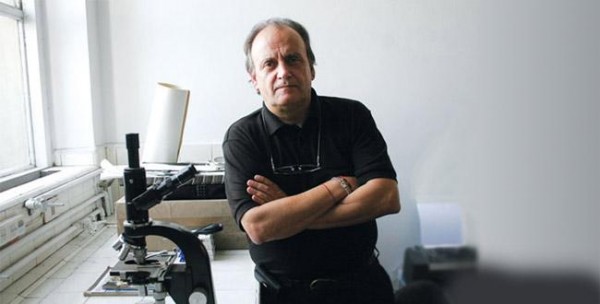by DARIO ARANDA (translated by DANICA JORDEN)

Autonomous Chair in Social Communication, scientist Andrés Carrasco recounted how he decided to reveal his research on the lethal effects of glyphosate: He was alone at the seaside fishing, enjoying the natural beauty of the spot he was in, knowing that what he had proved was essential, and he felt that in the perfect silence surrounding him was an immense scream: “Do something.” To do it, he needed to find “a serious and decent journalist.” And so he called Darío Aranda, who has chosen to publish his final farewell to Carrasco in lavaca. A double honor, one that obliges and requires us once again to continue to be worthy of it and them.
“I’m a researcher with Conicet[1] and I studied the impact of glyphosate in embryos. I’d like you to see this work.”
That was the first thing I heard at the other end of the telephone line.
It was 2009 and the debate over Resolution N°125 [2] was still developing. Página/12 [3] gave wide coverage to the consequences of the agri-food industry, and I had written about the effects of fumigating with agrochemicals.
The call made my wary. I did not know the caller. Why was he calling me?
The scientist continued with his presentation. “My name is Andrés Carrasco, I was the president of Conicet and I’m the head of the Laboratory for Embryology at UBA. I’ll give you my details.”
I had never heard of his name. I had never written about scientists, and Conicet sounded to me like a stamp.
I made calls to the paper and consulted various colleagues. Everyone confirmed that he was a recognized scientist, with a thirty-year career, had made very important discoveries in the 80’s, and worked consistently in the 90’s, when he confronted Menemism.
I wrote the article.
His research made the paper’s headline (April 2009). The news: Glyphosate, the main chemical for the soy industry, was lethal to amphibian embryos. Nothing went back to the way it was. Social organizations, campesinos, families who had been sprayed, and activists took Carrasco’s work as proof of what they had experienced in the territory.
“I didn’t discover anything new. I say the same as the families that have been sprayed, it’s only that I confirmed it in the laboratory,” he used to say. And so he began to be invited to all the encounters. From universities and scientific conventions, to gatherings of socio-environmental assemblies and fumigated schools. He tried to go everywhere, taking away time spent in the laboratory and with his family.
He also gained a lot of enemies. The first to criticize him: the agrochemical companies. Lawyers of Casafe (an organization of large agro corporations) went right to his laboratory at the Medicine School and harassed him. He started receiving anonymous threatening calls. And he was also denounced by the Minister of Science, Lino Barañao, who did it on the TV program of no less than Héctor Huergo, head of “Clarín Rural” (agribusiness section of Argentina’s major newspaper) and lobbyist for the corporations.
Upside Down World for more
